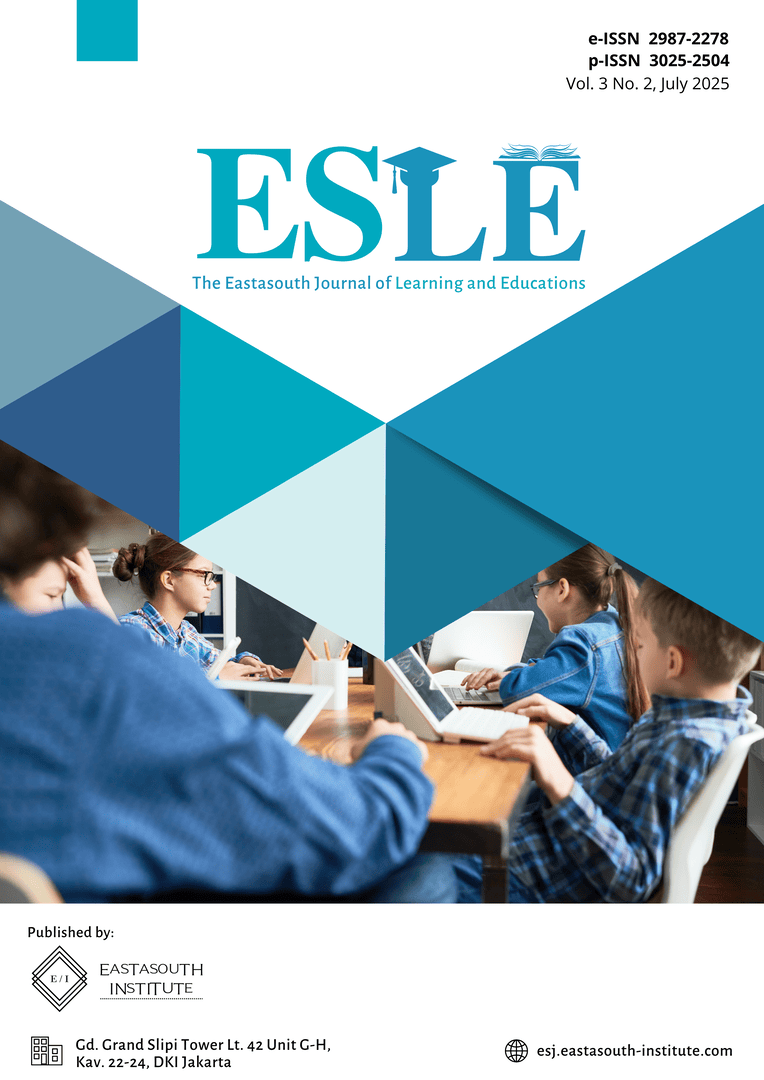Bibliometric Analysis of Rhizomatic Learning in Educational Research
Main Article Content
Abstract
This study presents a bibliometric analysis of scholarly literature on rhizomatic learning in educational research, aiming to uncover its intellectual structure, thematic developments, and collaborative patterns. Using data retrieved from the Scopus database (2008–2024) and analyzed with VOSviewer, the study visualizes co-citation networks, keyword co-occurrences, country collaborations, and temporal trends. The findings reveal that rhizomatic learning is conceptually grounded in poststructuralist philosophy, particularly the works of Gilles Deleuze and Félix Guattari, and is increasingly applied in digital pedagogy, professional development, and lifelong learning contexts. Central themes such as connectivism, new materialism, and multiplicity demonstrate the field’s interdisciplinary depth, while emerging topics like sustainability and adult learning reflect its practical expansion. The research also highlights a concentration of scholarly output in Anglophone countries and a predominance of qualitative methodologies. This study contributes to a deeper understanding of rhizomatic learning's evolution and offers a foundation for future inquiry that bridges theory, practice, and global educational needs.
Article Details

This work is licensed under a Creative Commons Attribution-ShareAlike 4.0 International License.
References
G. Deleuze and F. Guattari, EPZ thousand plateaus. A&C Black, 2004.
D. Cormier, “Rhizomatic education: Community as curriculum,” Innov. J. online Educ., vol. 4, no. 5, 2008.
A. Brailas, “Rhizomatic learning in action: A virtual exposition for demonstrating learning rhizomes,” in Eighth international conference on technological ecosystems for enhancing multiculturality, 2020, pp. 309–314.
A. Kairienė, “The rhizomatic learning from a perspective of poststructuralism,” J. Educ. Cult. Soc., vol. 11, no. 1, pp. 102–115, 2020.
L. Waltman, K. W. Boyack, G. Colavizza, and N. J. van Eck, “A principled methodology for comparing relatedness measures for clustering publications,” Quant. Sci. Stud., vol. 1, no. 2, pp. 691–713, 2020.
N. Van Eck and L. Waltman, “Software survey: VOSviewer, a computer program for bibliometric mapping,” Scientometrics, vol. 84, no. 2, pp. 523–538, 2010.
D. A. G. Clarke and J. Mcphie, “From places to paths: Learning for sustainability, teacher education and a philosophy of becoming,” Environ. Educ. Res., vol. 22, no. 7, pp. 1002–1024, 2016.
R. Bissola, B. Imperatori, and A. Biffi, “A rhizomatic learning process to create collective knowledge in entrepreneurship education: Open innovation and collaboration beyond boundaries,” Manag. Learn., vol. 48, no. 2, pp. 206–226, 2017.
J. Cabero Almenara and M. del C. Llorente Cejudo, “Information and communication technologies (IT): Formative scenarios and learning theories,” Rev. Lasallista Investig., vol. 12, no. 2, pp. 186–193, 2015.
C. Schaeffer, “Democratizing the flows of democracy: Patagonia Sin Represas in the awakening of Chile’s civil society,” in Social movements in Chile: Organization, trajectories, and political consequences, Springer, 2017, pp. 131–159.
M. Hordvik, A. MacPhail, and L. T. Ronglan, “Developing a pedagogy of teacher education using self-study: A rhizomatic examination of negotiating learning and practice,” Teach. Teach. Educ., vol. 88, p. 102969, 2020.
A. Bozkurt, S. Honeychurch, A. Caınes, M. Balı, A. Koutropoulos, and D. Cormıer, “Community tracking in a cMOOC and nomadic learner behavior identification on a connectivist rhizomatic learning network,” Turkish Online J. Distance Educ., vol. 17, no. 4, 2016.
J. Grellier, “Rhizomatic mapping: Spaces for learning in higher education,” High. Educ. Res. Dev., vol. 32, no. 1, pp. 83–95, 2013.
S. Carrington, “Service-learning within higher education: Rhizomatic interconnections between university and the real world,” Aust. J. Teach. Educ., vol. 36, no. 6, pp. 1–14, 2011.
O. Kaščák and B. Pupala, “Governmentality-Neoliberalism-Education: the Risk Perspective.,” J. Pedagog. Cas., vol. 2, no. 2, 2011.
M. Hordvik, A. MacPhail, and L. T. Ronglan, “Negotiating the complexity of teaching: A rhizomatic consideration of pre-service teachers’ school placement experiences,” Phys. Educ. Sport Pedagog., vol. 24, no. 5, pp. 447–462, 2019.
J. Mackness and F. Bell, “Rhizo14: A rhizomatic learning cMOOC in sunlight and in shade,” Open Prax., vol. 7, no. 1, pp. 25–38, 2015.
A. Lian and M. V. Pineda, “Rhizomatic learning:‘As… when… and if…’ A strategy for the ASEAN community in the 21st century,” Beyond Words, vol. 2, no. 1, pp. 1–28, 2014.
V. A. Ellis, “Introducing the creative learning principles: instructional tasks used to promote rhizomatic learning through creativity,” Clear. House A J. Educ. Strateg. Issues Ideas, vol. 89, no. 4–5, pp. 125–134, 2016.
J. C. D. Zaduski, R. B. Lopes, and K. S. Junior, “Initial considerations about a rhizomatic learning environment,” Rev. Ibero-Americana Estud. em Educ., pp. 489–499, 2018.
D. Harris, “Rhizomatic education and Deleuzian theory,” Open Learn. J. Open, Distance e-Learning, vol. 31, no. 3, pp. 219–232, 2016.

